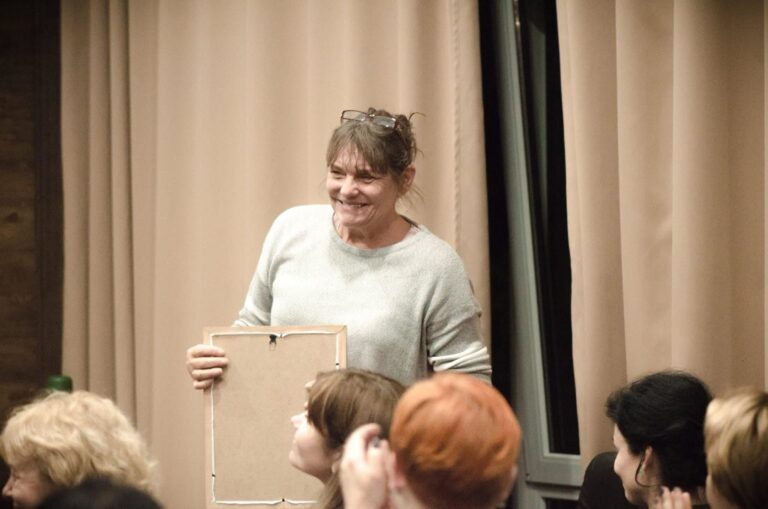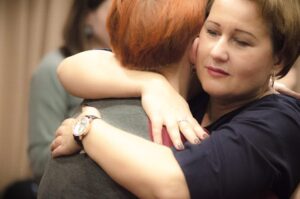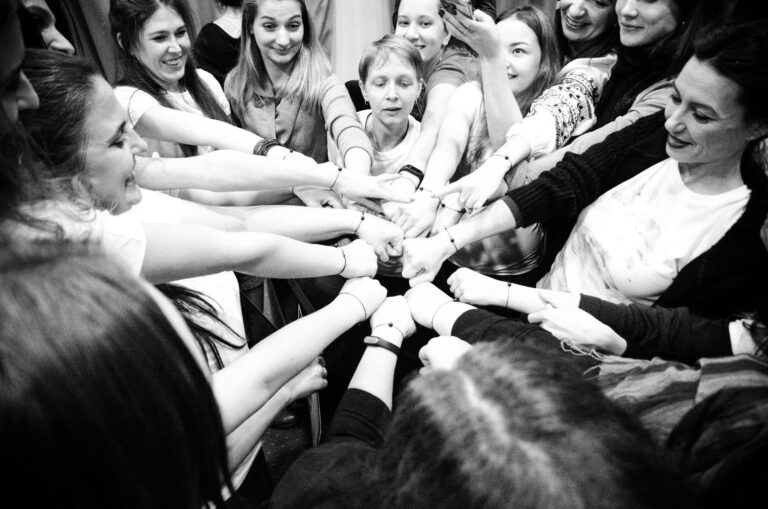Reclaiming Wholeness: Ukrainian Veterans and the Somatic Revolution of Healing
By Hadi Bahlawan-Marcher, Kristina Vasiljevaite Marcher & Dominic Mathias
Ukraine: When the Model Met the Moment
In 2015, in response to a rising mental health crisis among Ukrainian veterans, Bodynamic partnered with Pobratymy and local leaders. Under the guidance of Ditte Marcher (a global expert in veteran trauma), four full training cohorts launched.
This wasn’t therapy. It was co-education, a horizontal exchange and an invitation to embodiment. Veterans were not seen as broken. They were seen as wise, capable, and ready to lead their own healing.
Since then, Bodynamic International has worked in deep partnership with Ukrainian veteran-led organizations such as Pobratymy and Healing War Scars, co-creating trauma-informed training environments, honouring strength and not pathology.
This is not a story of therapy done to survivors, it is the story of a shared remembering: of dignity in the body, of wholeness in community and of a self trauma could not erase.

Beyond the Battlefield: Where War Hides
In the aftermath of war, healing is not simply the mending of wounds; it is an act of defiance. To reclaim dignity after devastation is to declare: I remain.
For Ukrainian veterans, healing is not a retreat from the frontlines but a continuation of their mission: this time waged within the body. It is a political, spiritual and biological resistance against the forces seeking to fragment identity, corrode agency and sever human connection.
The war does not end with ceasefires. It lives on in contracted spines, hypervigilant breath, frozen muscles and the silent spaces between people who can no longer speak in the sharp whispers of what they saw.
Healing as a Revolutionary Act: A New Alchemy
While conventional trauma models often focus on the mind, Bodynamics begins elsewhere: with the body’s integrity. Traumatic experience is encoded in posture, gesture, relational boundaries and the internal compass of selfhood.
Isolation, not just violence, is the true wound. And healing, at its core, is about relationship: between people, between parts of the self and between the psyche and soma.
The Science of Somatic Reconnection
The Bodynamic System, developed in Denmark over four decades ago, is among the world’s most integrative and empirically grounded somatic psychotherapies. Its roots draw from neuroscience, developmental psychology, muscle physiology and attachment theory. This follows a strong tradition, in which many key figures have taught us the importance of the soma:
- Bessel van der Kolk taught us that ‘the body keeps the score.’
- Gabor Maté reframed trauma as disconnection from the self, not the event.
- Antonio Damasio revealed emotions originate in the body.
- Stephen Porges’ Polyvagal Theory underscores the body’s capacity for co-regulation.
- Marianne Bentzen mapped the muscular and developmental imprints of trauma.
These voices converge in Bodynamic’s core principle: healing must occur through the body, not despite it.
What Sets Bodynamics Apart
While somatic therapies like Somatic Experiencing (SE) and NARM emphasize felt sense or narrative re-integration, Bodynamic stands apart through its clinical precision:
- 125 mapped muscles, each linked to specific psychological functions.
- Seven Character Structures, mirroring key developmental stages.
- The Bodymap, a clinically grounded somatic mapping system, developed from over 15,000 written records of therapeutic sessions with approximately 500 clients. It identifies patterns of muscular tension (hyper) and collapse (hypo) linked to psychological functions and developmental stages. Rather than offering fixed diagnoses, it helps therapists recognise embodied relational patterns and guide the therapeutic process with clarity and care.
- The Ego–Me–Norm model, which traces how trauma distorts social norms, personal will and identity.
Research by Eva Brendstrup confirms measurable results from Bodynamic interventions, especially in restoring emotional resilience post-trauma.
Its impact is widespread:
- Recognized by the Danish Psychotherapy Association
- Studied by pioneers like Peter Levine, Babette Rothschild and Raja Selvam under the expert tutelage of Lisbeth Marcher.
- Built upon foundational work by Lisbeth Marcher and expanded by generations to follow.
Today, trainings stretch across Europe, Asia, and North America, continuing to evolve. But the essence remains: the Bodymap, the Ego-Me-Norm model and the Bodyknot trauma framework guide both therapy and teaching.
Rather than simply asking, ‘What happened to you?’, Bodynamic asks two even more essential questions:
How did your body adapt to survive?
What do you now need to come home to yourself?
Healing the Invisible Frontline: Scientific Insights from the Wives of Veterans

While much focus has been placed on veterans, their wives (often the invisible carriers of trauma) also live in the aftermath of war. In 2017, a Bodynamic training cohort was launched specifically for 27 wives of ATO veterans in Ukraine. This initiative, supported by Bodynamic International, the Canada Fund for Local Initiatives, and the Canadian Embassy in Ukraine, offered not only trauma education but also a space for reconnection, embodied self-awareness, and collective healing.
Measurable Impact on PTSD and Alienation
The training included four intensive modules and was accompanied by rigorous psychological assessment. Participants were evaluated using internationally recognized measures of trauma, dissociation, depression, and post-traumatic growth.
The results were powerful:
PTSD symptoms (PCL-5) showed a significant decline. The percentage of women experiencing symptoms of alienation dropped from 85.2% to 24%. A 61.2% reduction.
Avoidance, intrusive memories, and hyperarousal symptoms also significantly declined across the course.
The number of participants experiencing all four PTSD symptom clusters fell dramatically from 63% at the start to 18.5% by the final stage.
Depression and Dissociation: A Gradual Softening
While reductions in depressive and dissociative symptoms (PHQ-9 and DES) were not statistically significant, there was a clear downward trend. Severe depression was no longer observed by the end of the training and more participants reported experiencing only mild or no depressive symptoms.
Growth After Trauma: The Quiet Revolution
One of the most compelling aspects of the study was the evidence of post-traumatic growth (PTGI):
There was a notable rise in the subscales ‘closeness with others’ and ‘willingness to express emotions.’
Women reported greater ability to lean on others, express vulnerability and trust relationships: an extraordinary shift in a culture where stoicism often masks internal suffering.
Statistically, the willingness to express emotion was negatively correlated with PTSD symptoms (r = -0.439, p < 0.05), suggesting emotional openness was a pathway to recovery.
A Different Kind of Strength
Interestingly, some traditional growth markers, such as ‘I discovered that I’m stronger than I thought I was’ did not rise. Instead, many women reported a deepened sense of interdependence and emotional expressiveness. Strength, in this context, was redefined not as toughness, but as the capacity to be moved, to relate, and to feel.
They learned:
- Grounding and nervous system regulation
- The physiology of trauma
- Rebuilding trust, voice, and internal boundaries
- Supporting others without abandoning the self
The battlefield may have shaped them, but it did not define them. Healing returned that fundamental right. These women carried not just personal trauma but inherited silence: generations of suppressed voice, agency and recognition.
This was not a one-way path of learning either; their presence also reshaped the methodology itself:
- Increased focus on consent, boundaries, and embodied voice
- Affirmation of identity beyond roles (mother, soldier, caretaker)
- A reclamation of femininity not as vulnerability, but as radical wholeness
This was beyond recovery, it was redefinition. The testimonies of four women stood in relief and their vivid experience elucidates four key elements of trauma: shock, developmental, horror shock and Complex PTSD. They represent the four faces of trauma and the journey of a brave return through witnessing and declaration:
The Body Under Siege
Shock Trauma: acute, life-threatening overwhelm that freezes the body.
Vasyl: near a shell blast, returned ghostlike, legs unreliable, breath shallow. In training, he learned trauma didn’t live in memory alone but in his spine. With grounding, slow contact and safe co-regulation, his internal stability returned.
The Self Denied
Developmental Trauma: long-term disconnection in childhood that shapes the adult self.
Elena: she was a caregiver whose arms never rested. ‘I don’t think I have trauma,’ she said. But when told, ‘You don’t need to care for us,’ she wept. She wasn’t just learning how to support, she was learning how to be.
The Witness’s Burden
Horror Shock: witnessed or imagined trauma, often with helplessness.
Irina: a mother and commander who had no room for needs. Her body was armoured, her voice unused to softness. When she whispered, ‘I want to be held,’ her shoulders softened. Her humanity emerged.
Care Without Self
Complex PTSD: layered trauma over time, often from caregiving or neglect.
Natalia: never fought but relived the war through her brother. Her jaw locked, her eyes vigilant. In grounding work, she murmured, ‘He came back. But I never left the war.’ She began to return, too.
Implications for the Future: Rethinking Recovery, Resilience, and Relational Healing
The findings from the Bodynamic training with veterans’ wives in Ukraine do more than confirm the efficacy of somatic methods: they invite a fundamental re-evaluation of how we conceptualize trauma recovery. These women, who bore the secondary, yet no less potent burdens of war, did not need traditional therapy in the clinical sense. They needed a space to remember themselves, not merely as supporters of others, but as full human beings with their own inner landscapes, ruptures and longings.
Trauma as Relational Disruption
The research highlights what trauma theorists are increasingly emphasizing: trauma is not just an individual pathology; it is a relational wound. The sharpest reductions in PTSD symptoms were found in areas tied to alienation and emotional inaccessibility. What healed most was not simply the memory of the trauma, but the loss of connection trauma created. This finding urges clinicians and program developers to foreground community, attunement and mutual recognition in trauma interventions, especially in post-conflict and displacement settings.
From Resilience to Relational Intelligence
Post-traumatic growth in this context did not always look like independence or personal triumph. Rather, it took the shape of expressing emotion, leaning on others and embracing vulnerability, capacities often undervalued in trauma discourse shaped by military or heroic narratives. This invites a broader cultural shift: from fetishizing ‘resilience’ as stoic endurance, to cultivating relational intelligence and embodied self-awareness as markers of true healing.
A Call for Gender-Informed Somatic Research
The inclusion of women’s voices in this study opens new terrain. The wives of veterans, like many women in war zones, often go uncounted in the statistics and unrecognized in the therapeutic frameworks. Yet they shoulder invisible burdens of caregiving, emotional labour, intergenerational trauma and social expectation. The research suggests gendered trauma (especially the repression of voice and boundaries) requires gender-informed somatic models. Future studies could explore how character structures and muscle patterns express differently across gender identities, roles, and cultural contexts.
Towards a New Ethics of Healing
Perhaps most importantly, this study affirms trauma work must move beyond diagnosis toward dignity. Healing is not about symptom reduction alone; it is about restoring the sense of belonging in one’s own body and in the shared human story. Bodynamic’s approach, with its attention to developmental stages, muscle responsiveness and ethical attunement, offers a blueprint for a trauma-informed ethics grounded in agency, mutual respect and embodiment.

Trauma Requires Precision, Not Just Compassion
Empathy is not enough. Survivors need tools: clinical, developmental, relational. Bodynamic provides them:
- Specific muscle-based diagnostics
- Developmentally rooted interventions
- Restorative movement practices
- Dignity-centred therapeutic stance
This is not healing through catharsis – it is functional reclamation: the adult-self-restored in mutual connection with dignity.
Somatic Dignity: A Universal Human Right
Imagine if therapy was not about fixing but about restoring inner authority. The right to feel whole, not because life was easy, but because dignity is indestructible.
Bodynamic envisions this future:
One muscle at a time. One relationship at a time. One act of embodied remembrance at a time.
In an Age of Disconnection: Coming Home to the Body
Ours is a world saturated in burnout, algorithmic distraction, climate dread and systemic violence. Disconnection has become endemic. And yet, across Ukraine, across borders, something remarkable is happening: veterans are teaching us the body is not a battlefield; it is a sanctuary. Healing is not a luxury. It is an imperative – a re-membering and a return to what it means to be oneself.
With Deepest Gratitude
To the Ukrainian veterans: your courage is a light in the dark.
To the women of the training: you redefined what healing looks like.
To the team; your presence changed the field:
Ditte Marcher, Oleh Hukovskyy, Oleh Novak, Taras Kovalyk, Artem Denysov, Ivona Kostyna, Andriy Kozinchuk, Ighor Kholodylo, Валерій Чоботар and Alina Viatkina.
To Lisbeth Marcher and the lineage of Bodynamic: this is your living legacy.
To every trauma survivor: your body remembers the way home.
